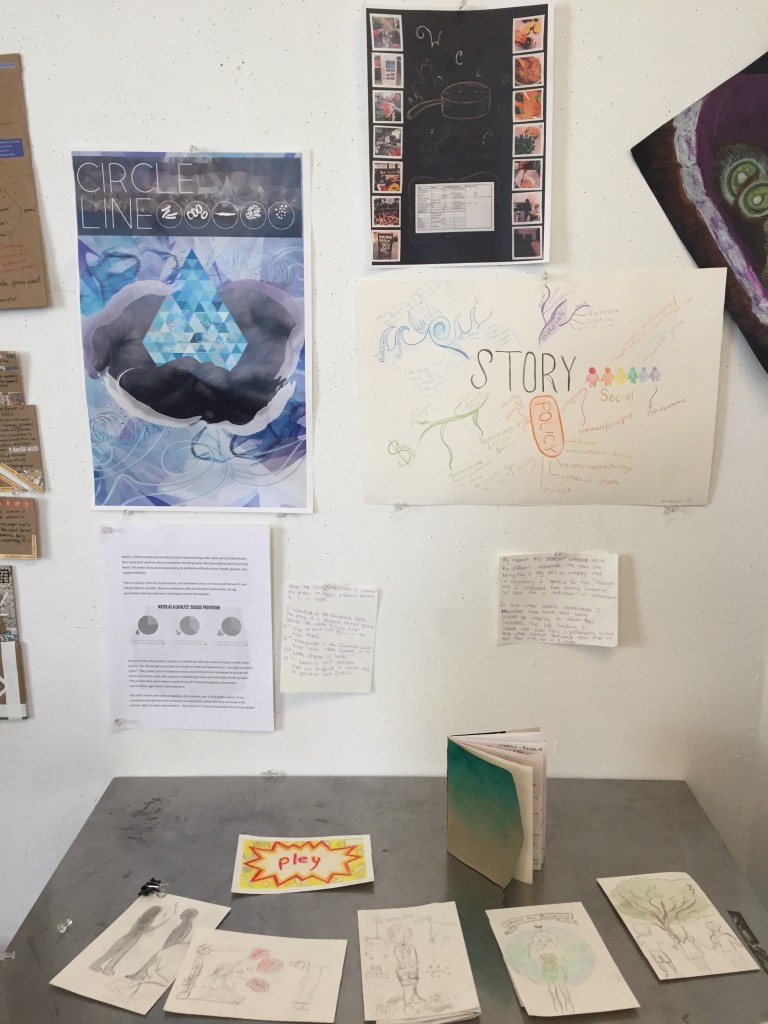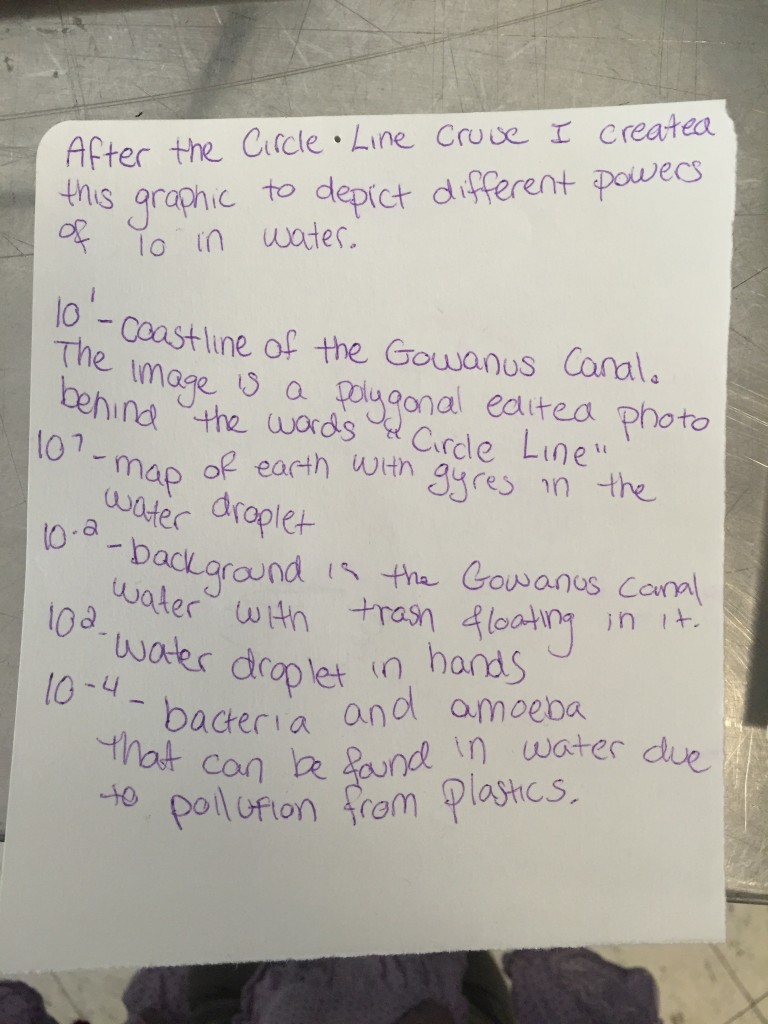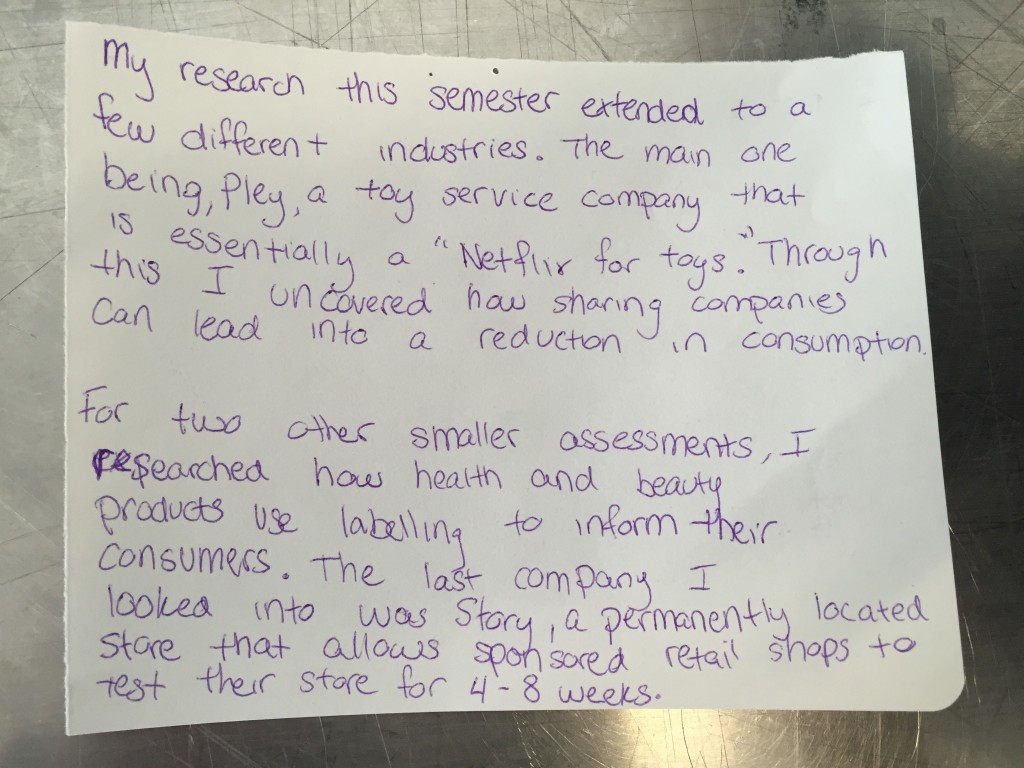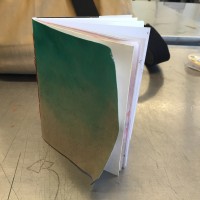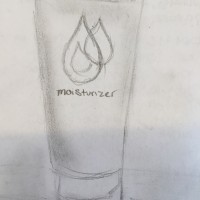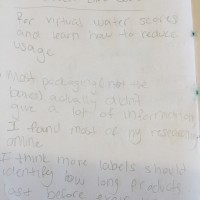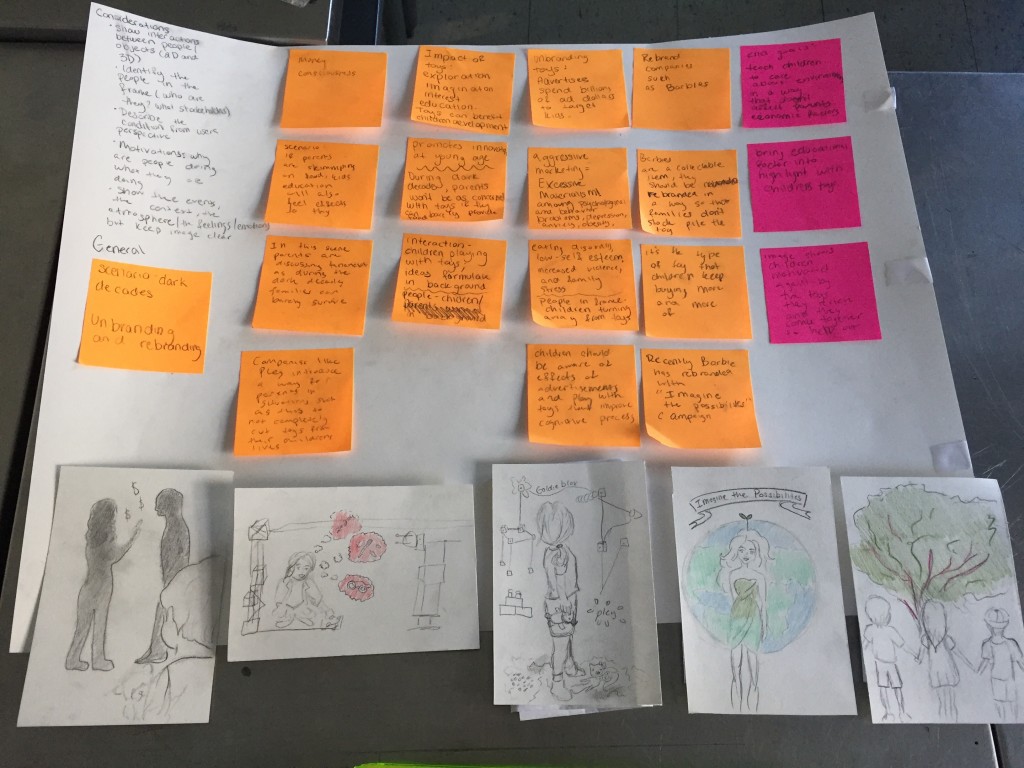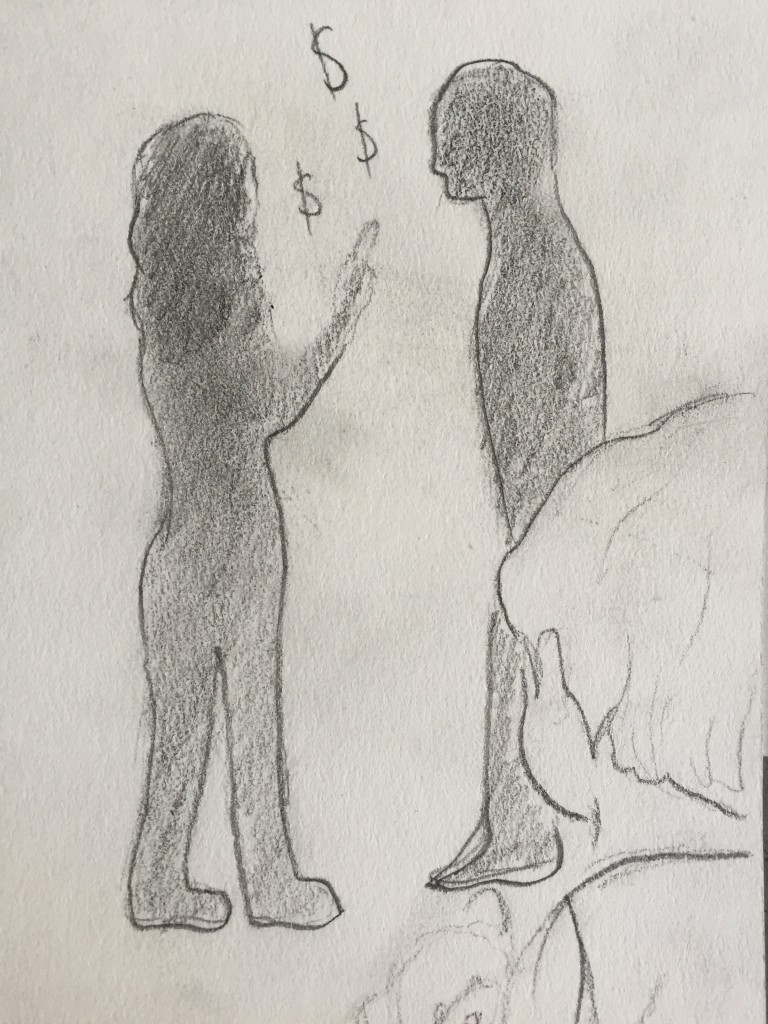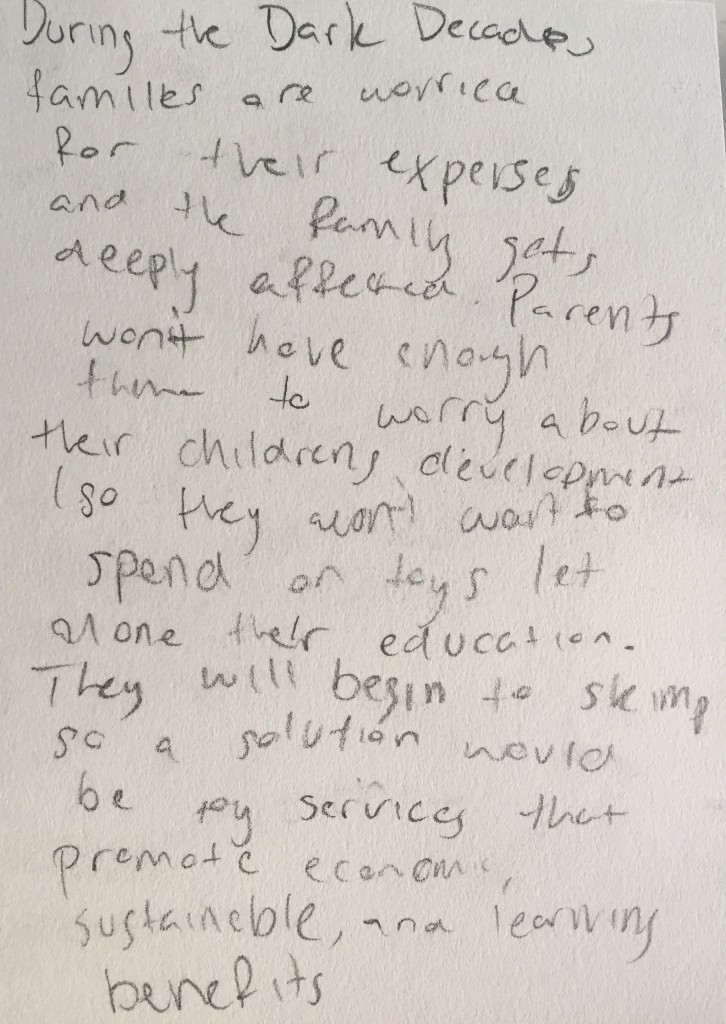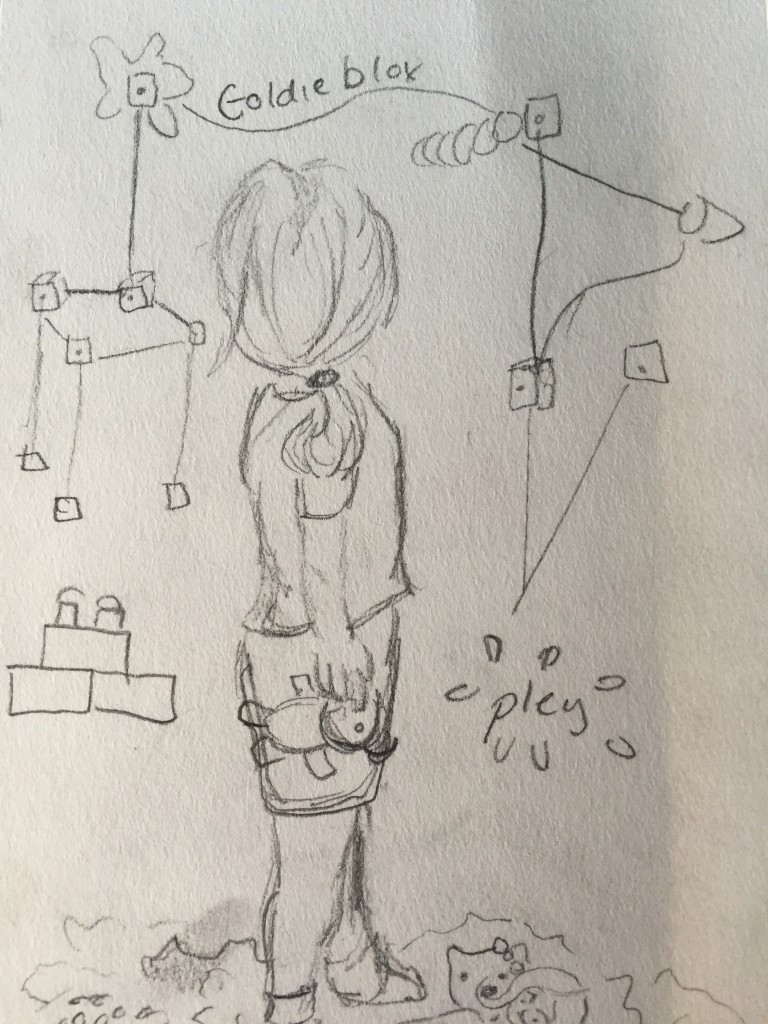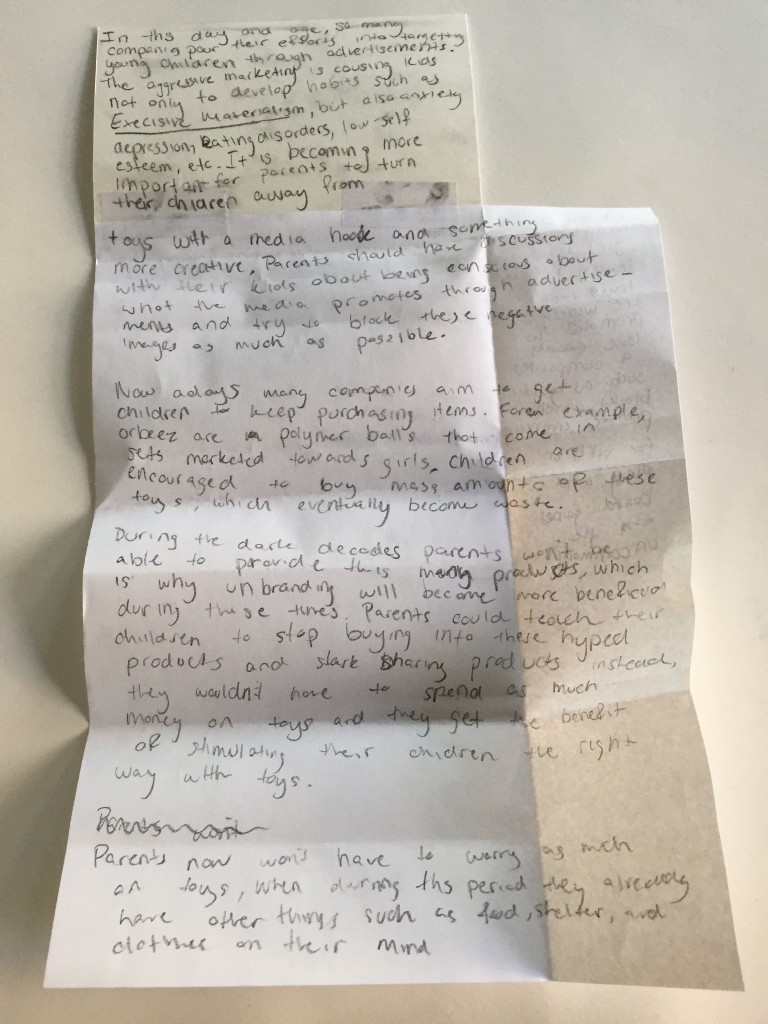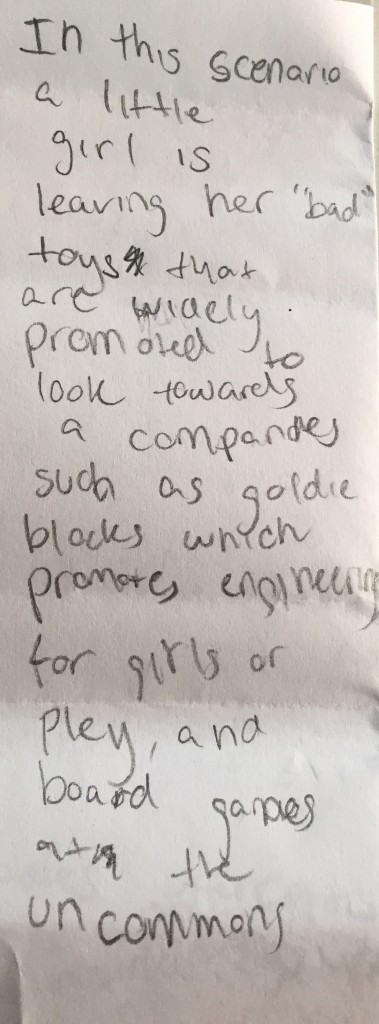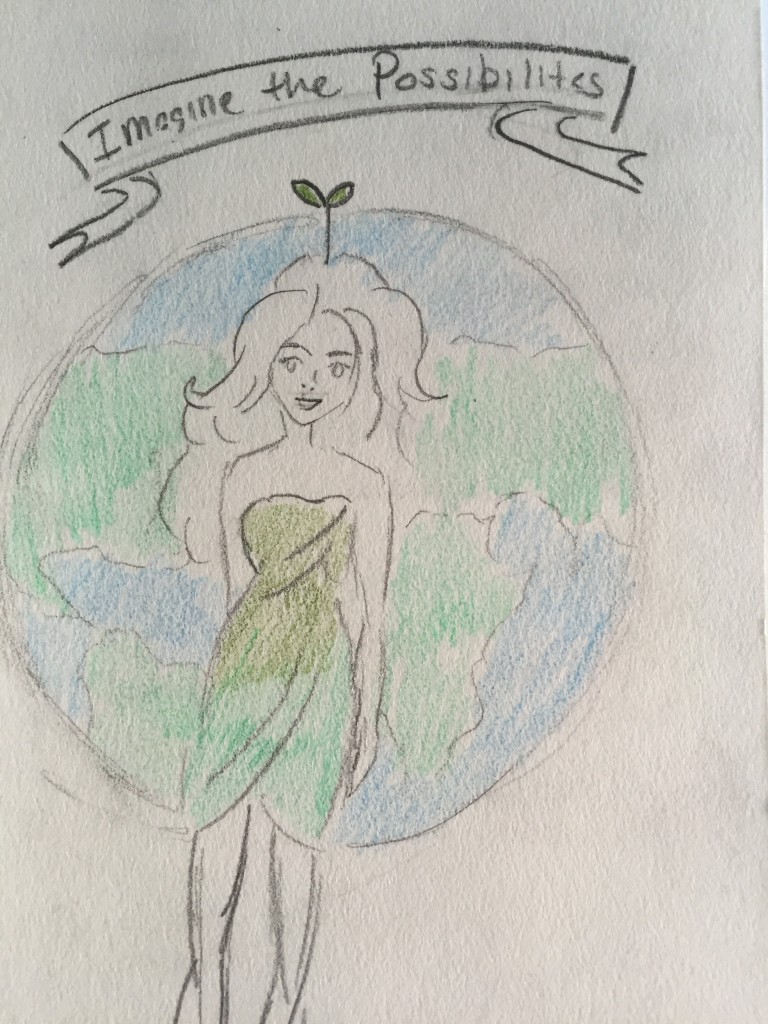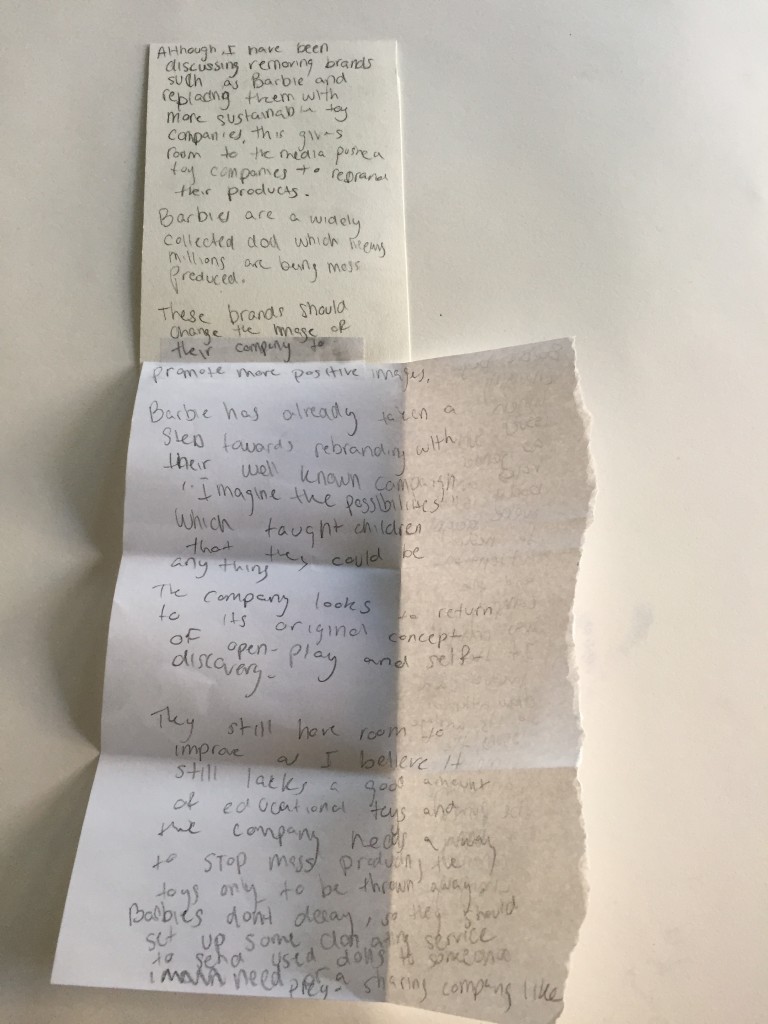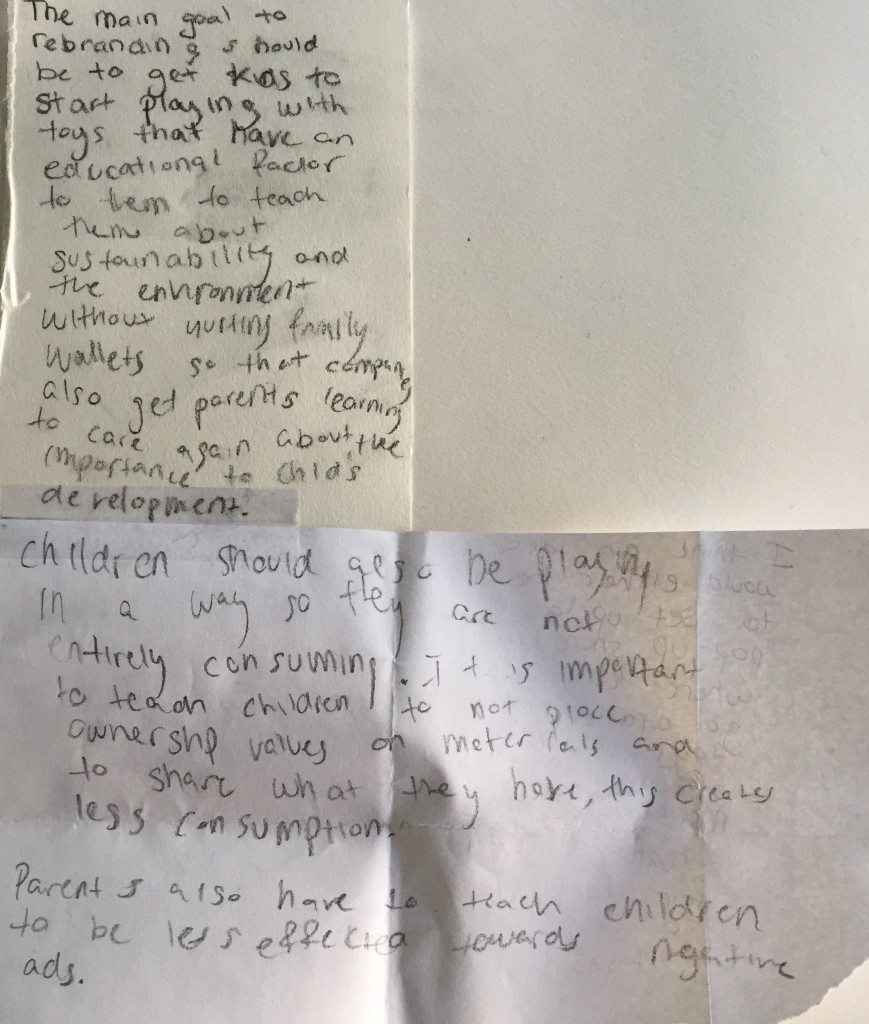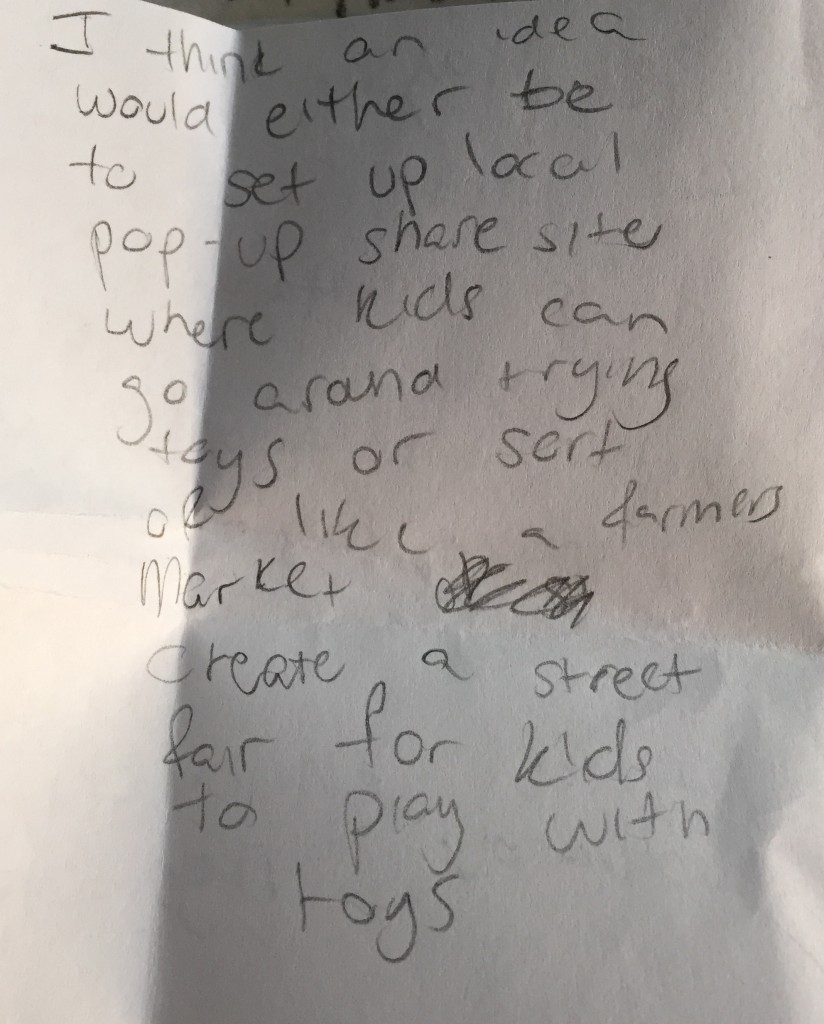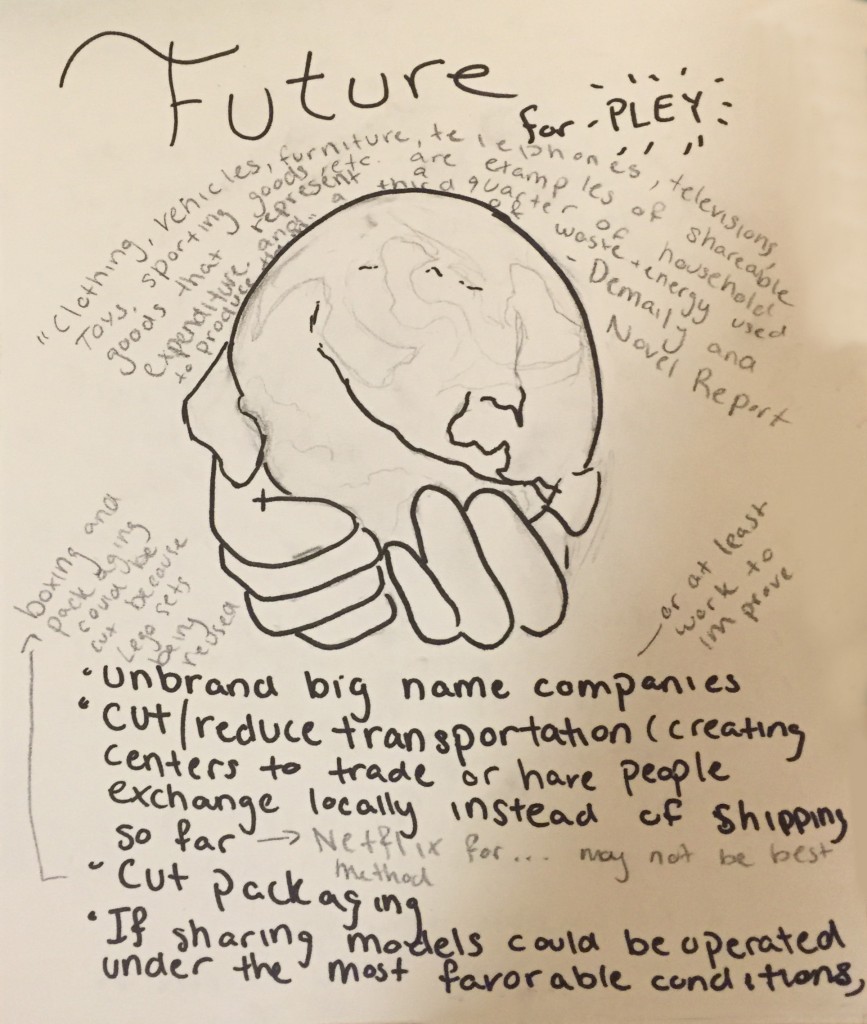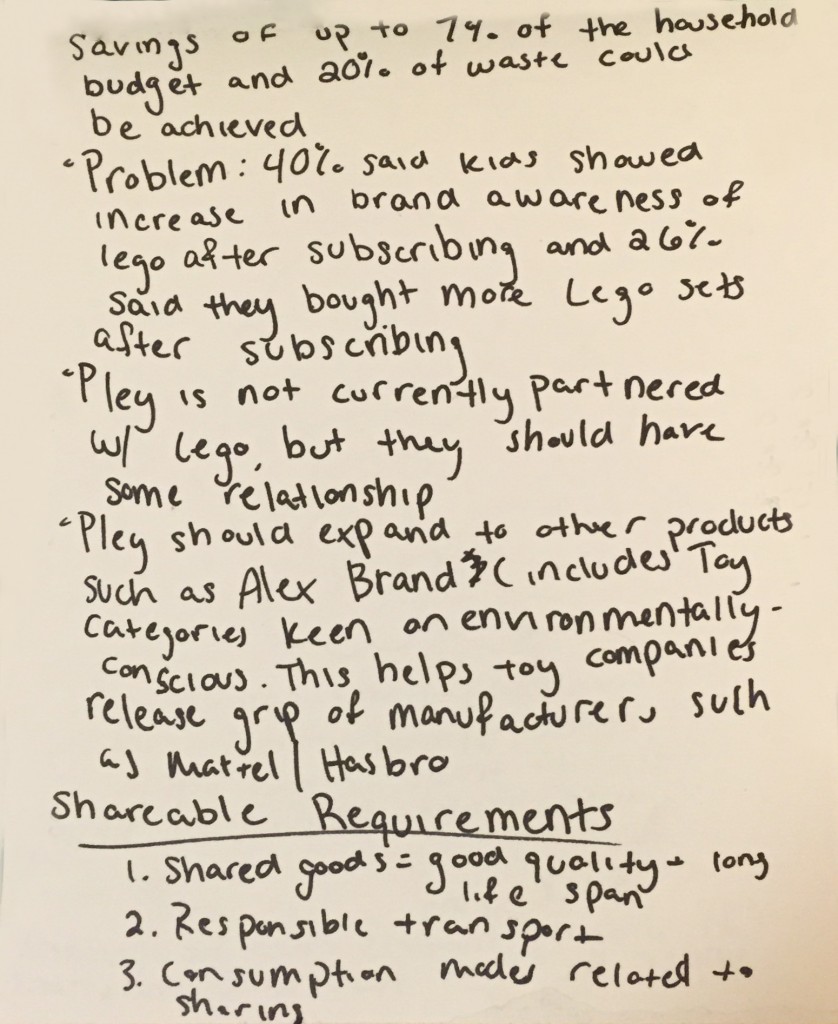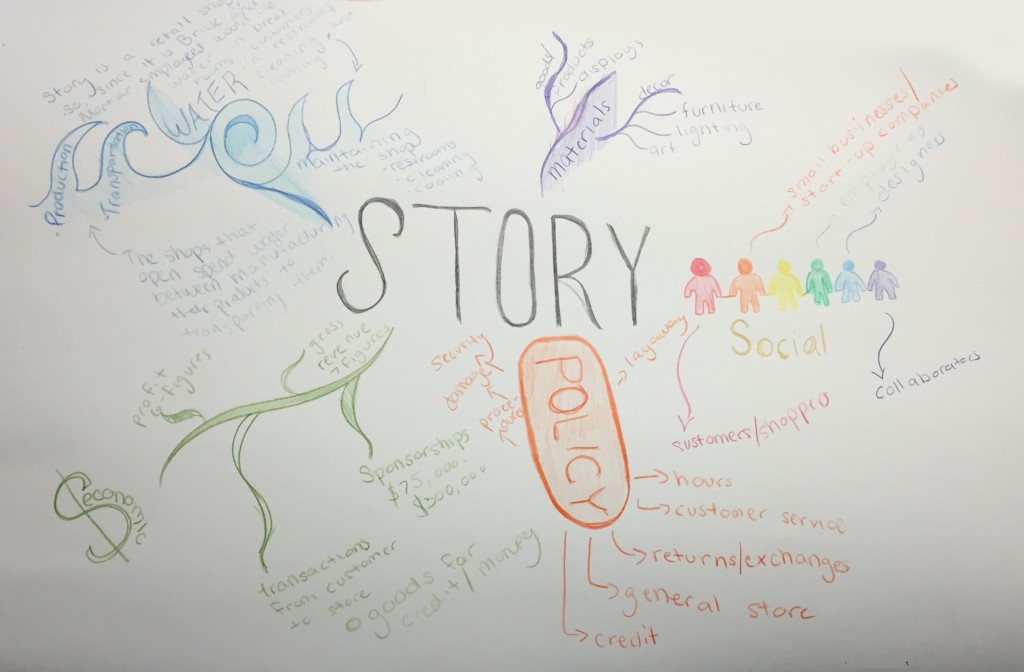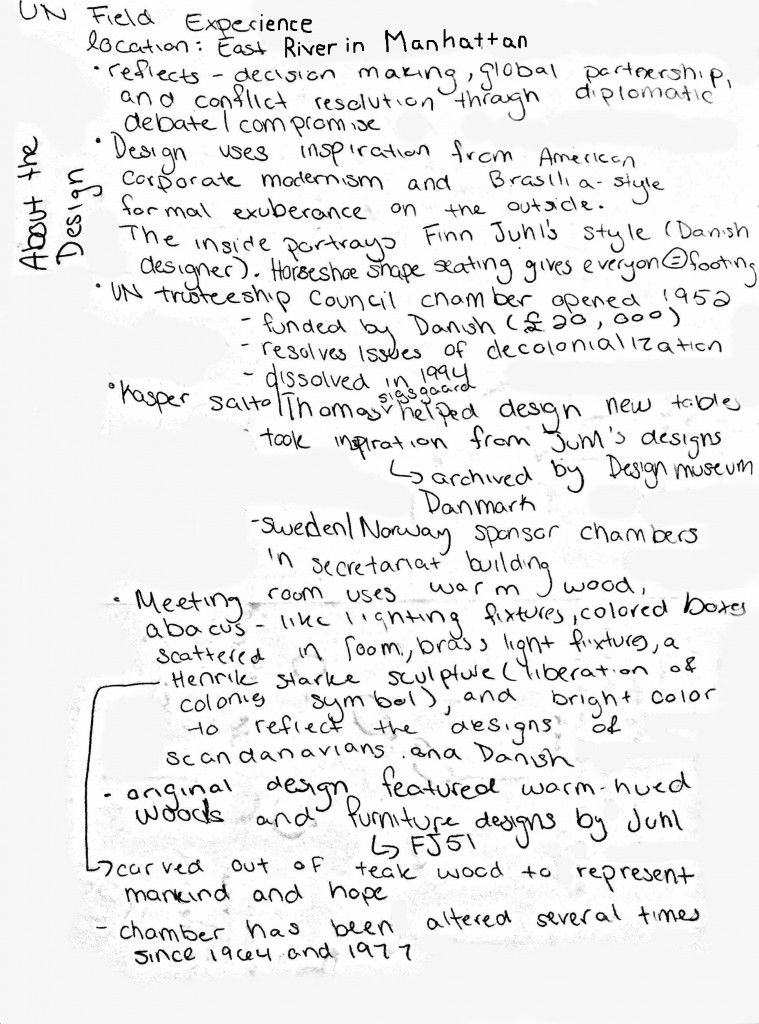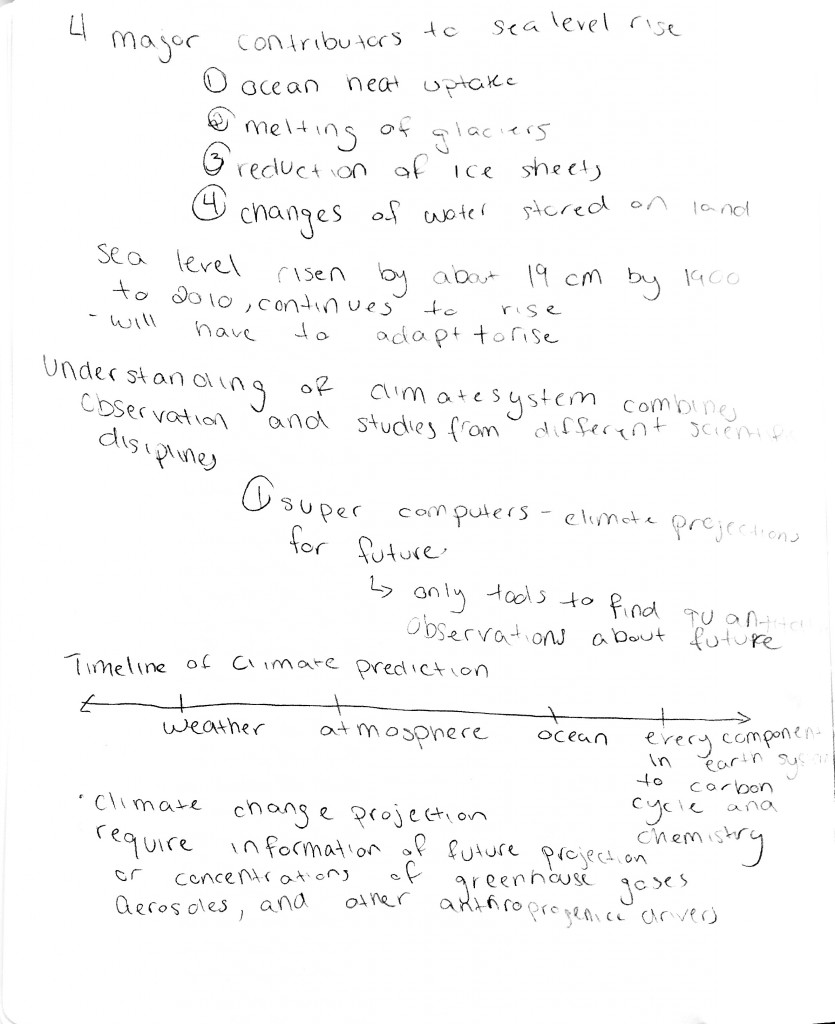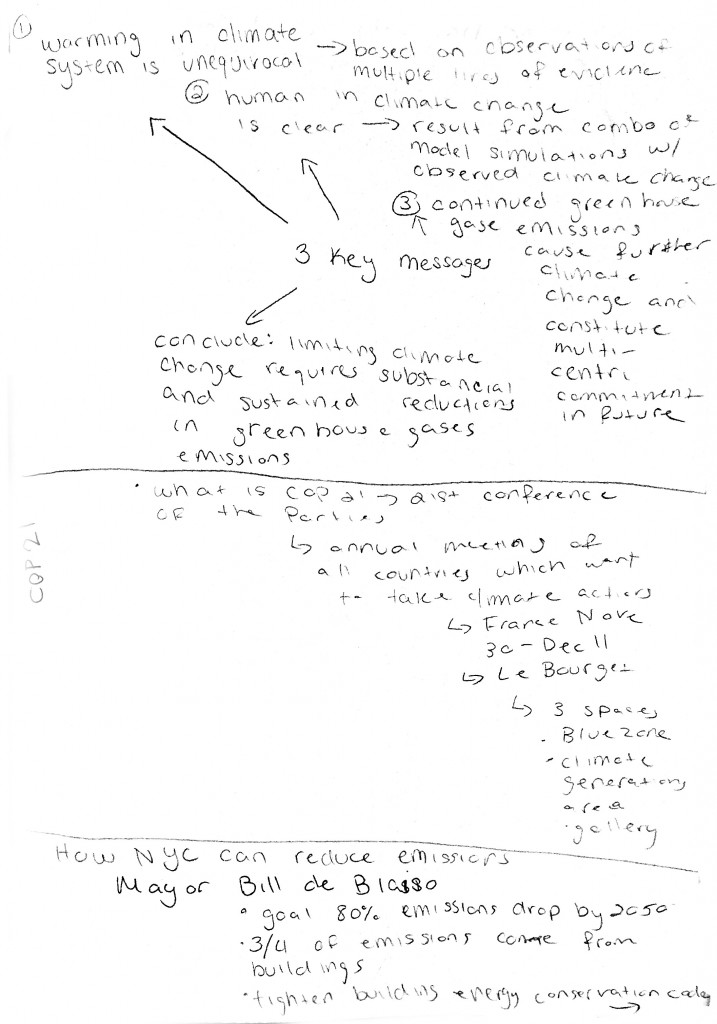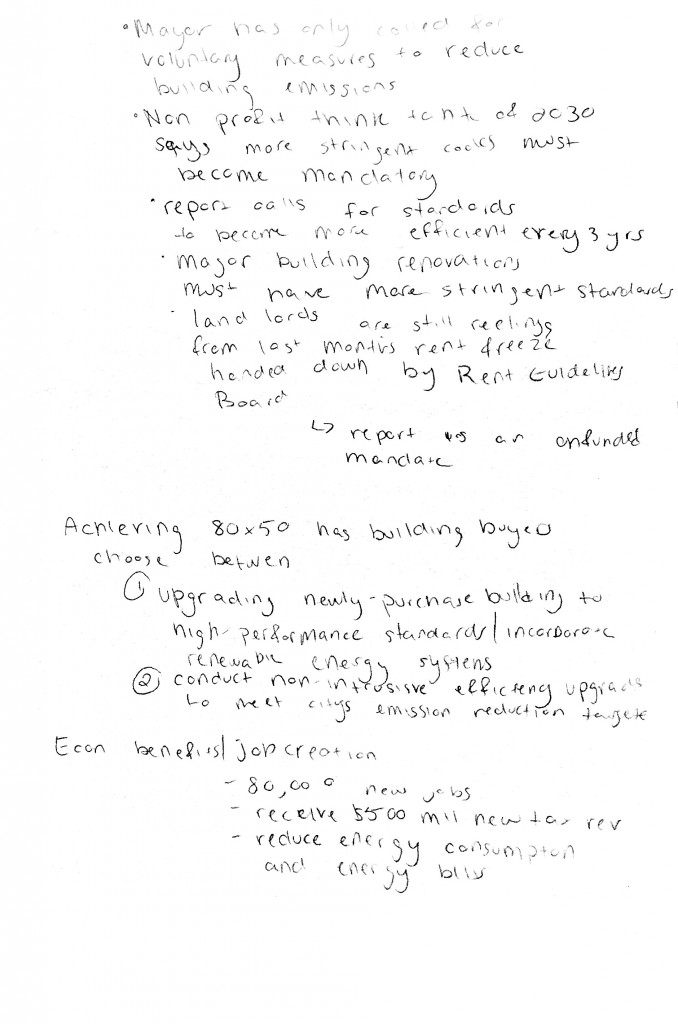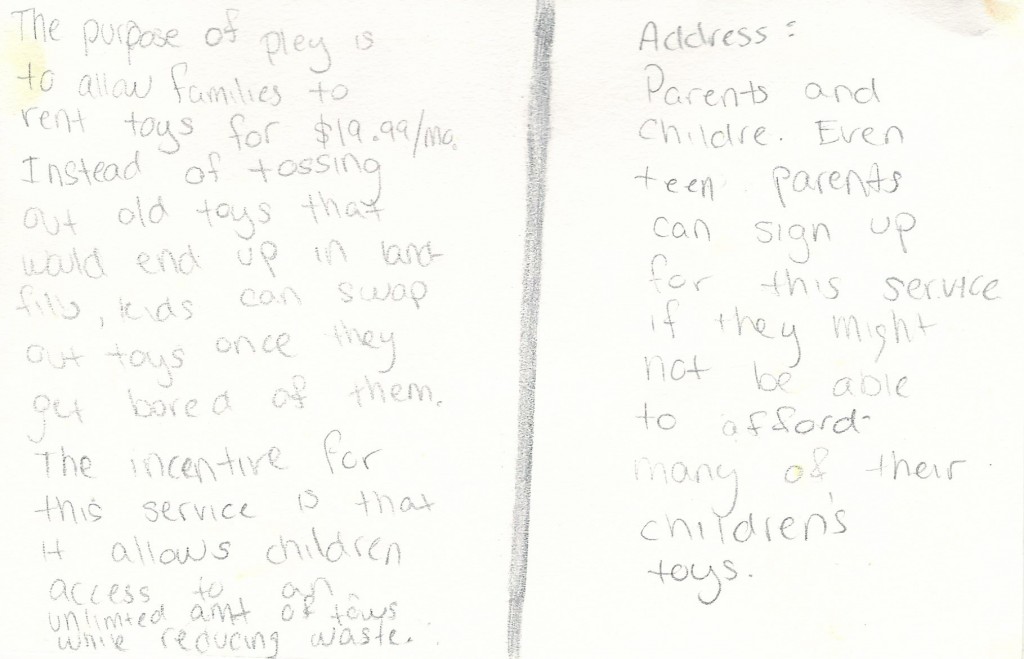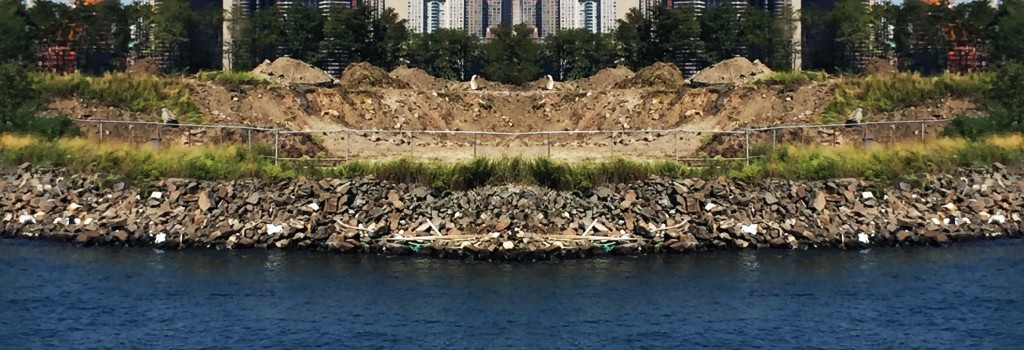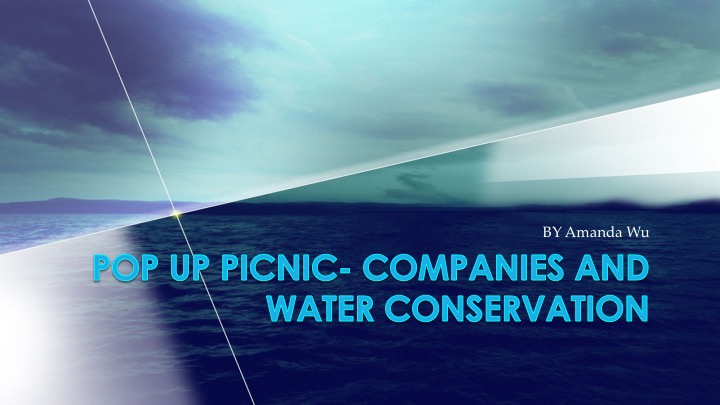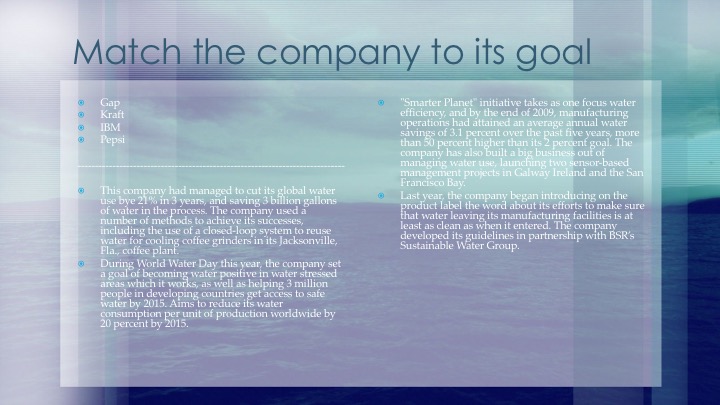About the companies and Industries I researched
Category: Sustainable Systems
Field Action – Health and Beauty Projects
Future Post Cards
I had a hard time scanning in these post cards because of their size, so instead, at the bottom of each photograph I rewrote what was written in each postcard to make it easy to read instead of my handwriting.
During the Dark Decades, families are worried for their expenses and the family gets deeply effected. Parents won’t have enough time to worry about their children’s development, so they won’t want to spend on toys let alone their education. They will begin to skimp, so a solution would be toy services that promote economic, sustainable, and learning benefits.
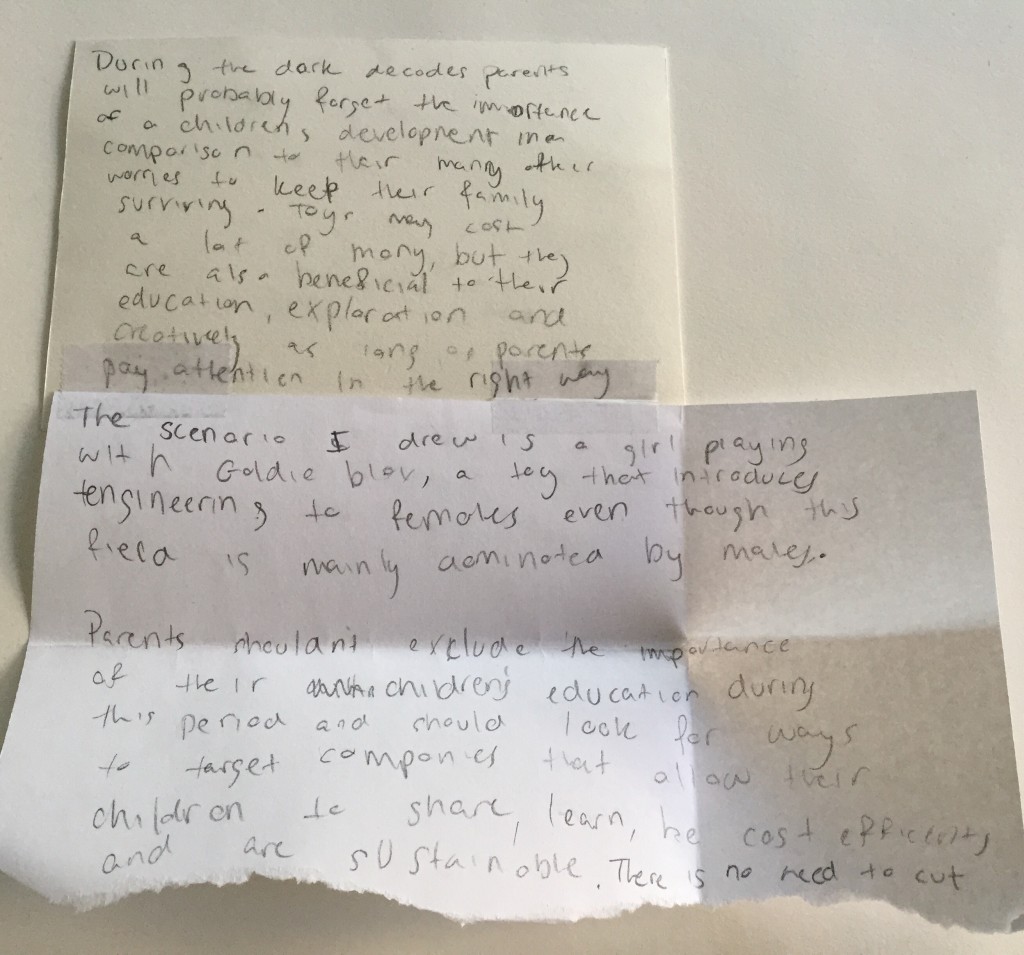 During the dark decades, parents will probably forget the importance of a child’s development in comparison to their many other worries to keep the family surviving. Toys may cost a lot of money, but they are also beneficial to their kid’s education, exploration and creativity as long as parents pay attention in the right way.
During the dark decades, parents will probably forget the importance of a child’s development in comparison to their many other worries to keep the family surviving. Toys may cost a lot of money, but they are also beneficial to their kid’s education, exploration and creativity as long as parents pay attention in the right way.
The scenario I drew is a girl playing with Goldie Blox, a toy that introduces engineering to females even though the field is mainly dominated by males.
Parents shouldn’t exclude the importance of their child’s development during this period and should look for ways and solutions to target companies that allow their children to share, learn , be cost, and are sustainable. There is no need to cut.
In this day and age, so many companies pour their efforts into targeting young children through advertisement. The aggressive marketing is causing kids not only to develop habits such as excessive materialism, but also anxiety, depression, eating disorders, low self-esteem, etc. It is becoming more important for parents to turn their children away from toys with a media hook and something more creative. Parents should have discussions with their kids about being conscious about what the media promotes through advertisements and try to block these negative images as much as possible.
Now a days , many companies aim to get children to keep purchasing items. For example, Orbeez are polymer balls that come in sets marketed towards girls. Children are encouraged to buy mass amounts of these toys, which eventually become waste.
During the Dark Decades parents won’t be able to provide this many products, which is why unbranding will become more beneficial during these times. Parents could teach their children to stop buying into these hyped products an start sharing products instead, they wouldn’t have to spend as much money on toys and they get the benefit of always stimulating their children the right way with toys.
Parents now won’t have to worry as much on toys, when during this period they already have other things such as food, shelter, and clothes on their mind.
In this scenario a little girl is leaving her “bad” toys that are widely promoted to look towards a company such as Goldie Blox which promotes engineering for girls or Pley, and board games at The Uncommons.
Although I have been discussing removing brands such as Barbie and replacing them with more sustainable toy companies, this gives room to media preferred toy companies to rebrand their products. Barbies are widely collected dolls, which means millions are being mass produced These brands should change their image their company to promote more positive images.
Barbie has already taken a step towards rebranding with their well known company “Imagine the Possibilities”, which taught children that they could be anything. The company looks to return to its original concept of open-play and self-discovery.
They still have room to improve as I believe it still lacks a good amount of educational toys and the company needs a way to stop mass producing the toys only to be thrown away. Barbie’s don’t decay, so they should set up some sort of donation service to send to send used dolls to someone in need or a sharing company like Pley.
Barbie began changing when issues such as gender roles and body issues were brought to media attention and the company was critiqued. If the media can draw attention to its wastage issues, the company can change and be pushed to continue changing.
The main goal to rebranding should be to get kids to start playing with toys that have an educational factor to them to teach them about sustainability and the environment without hurting the family’s wallet so that companies also get parents learning to care again about the importance to child’s development.
Children should also be playing in a way so that they are not entirely consuming all the time. It is important to teach children to not place ownership values on materials and to share what they have, this creates less consumption.
Parents also have to teach children to be less effected towards negative ads.
I think an idea would either be to set up local pop-up share sites where kids can go around trying toys or a sort of farmer’s market and create a street fair for kids to play with toys.
Timeline to 2050 – Pley
The company I have been focusing on for this project is Pley. They are essentially a “Netflix for Toys” that allows families to rent Lego sets. Although they do look to expand to other types of toys, this is the product they are primarily focusing on right now.
For the beginning of this time line I wanted to focus on the company Pley focuses on, which is Legos, as well as a few other top toy brands. I discussed a few of the environmental problems Lego has suffered with in the past. This begins with when Lego paired up with Shell the oil company and promoted Shell in order to heighten its own PR and products.
I then go in to discuss some other problems within the toy industry as a whole such as major companies using AAP to package their products, even though they are linked to deforestation in Indonesia or even when toys were recalled for containing lead in them.
For the future I wanted to emphasize on the areas that Pley still needs to look into in order to improve their company and become more eco-friendly. For example, although this renting service is a good idea, the problem occurs that the products still emits a lot of fuels in order to constantly ship in and out the products to one main headquarters. Perhaps a better solution for this problem is for Pley to set up more of a Blockbuster for toys and parents can pick up the Lego set for locally.
I also think that because Pley doesn’t need flashy packaging in order to entice service members to buy the product, the company can cut down costs of packaging. Instead they can reuse packaging that does get shipped out or if there was more of a Brick and Mortar type store, packaging would be skipped over all.
Story Mind Map
Story is a permanently located retail store that allows retail shops to be sponsored. A store will be set up for four to eight weeks where they are given 2000 square feet of space to test out their companies. It is similar to those lab areas or shared spaces where people can work on their company. However, with this model, companies have to ability to test out their businesses with actual customers before they actually launch.
New York Times goes in to detail about some of the companies successes. There have been a variety of types of companies that have already set up shop here. There have been typical retail shops that sells products such as makeup, speakers, notebooks, etc. They have also branched off into services such as creating a Wellness yoga studio. But, one of the most unique opportunities Story has worked with was sponsored by General Electric which created a Makers Studio when customers were inclined to trying technologies such as the 3D printer or a robot that draws. Because a certain product couldn’t be sold in that project, most of the Story owner’s revenue came from the sponsorship.
When switching stores, Story also shuts down for an entire week to rebuild the shop. At the moment there are no signs of expansion for the company, although they do hope to expand their social media presence.
Detailing the Systems
Water systems –
Production
Transportation (Similar to what we calculated with the food project)
Maintenance – Cleaning the store as well as plumbing, restrooms, Air Condition, etc. Anything that keeps the shop running can need water.
Material systems –
Goods/Products – The items being purchased itself
Displays – Tables and mannequins that may display the products
Decor – The store must change any of the decor around the store every time a new store is established. Story makes sure each shop is themed and the decor and furniture around the shop reflects this theme.
Social systems –
Customers/Shoppers
Start-up companies
Sponsors
Designers – ” Much of what’s for sale comes from small brands and designers, some of whom were discovered at a “pitch night” where designers offer their wares to Ms. Shechtman and her team. And while most merchandise changes with each new theme, there are a few constants, like some jewelry and a stash of New York City items kept on hand for tourists.” – (New York Times)
Staff
Collaborators – The store holds many events and sometimes collaborate and promote people or shops that are not included in the month-long themed shop.
Economic systems –
Transactions – Customers pay for the goods or service
Sponsorship – The owner of Story makes her revenue through Sponsorships, which are the companies that buy the space for the month. She also gets a percentage of the profit made through the customer transactions.
Political systems –
There are many policies that go into setting up a retail store that are the support systems to put a business in place and keep it alive.
Security – many companies suffer from crime losses. This helps decrease chances of robberies, by techniques such as decreasing the amount of cash left in the register. It is a measure taken to maintain daily operations.
Procedure – This is general store policies such as handling damage, house keeping, gift registry, donations, gift wrapping, power failure, etc.
Lay away – Ask questions such as will the store include lay away, how much is customer required to lay down, where are lay away items stored, etc?
Hours – business hours and store hours.
Customer services
Returns/exchange
Credit – How will the company accept transactions
UN Notes
Post card – Pley
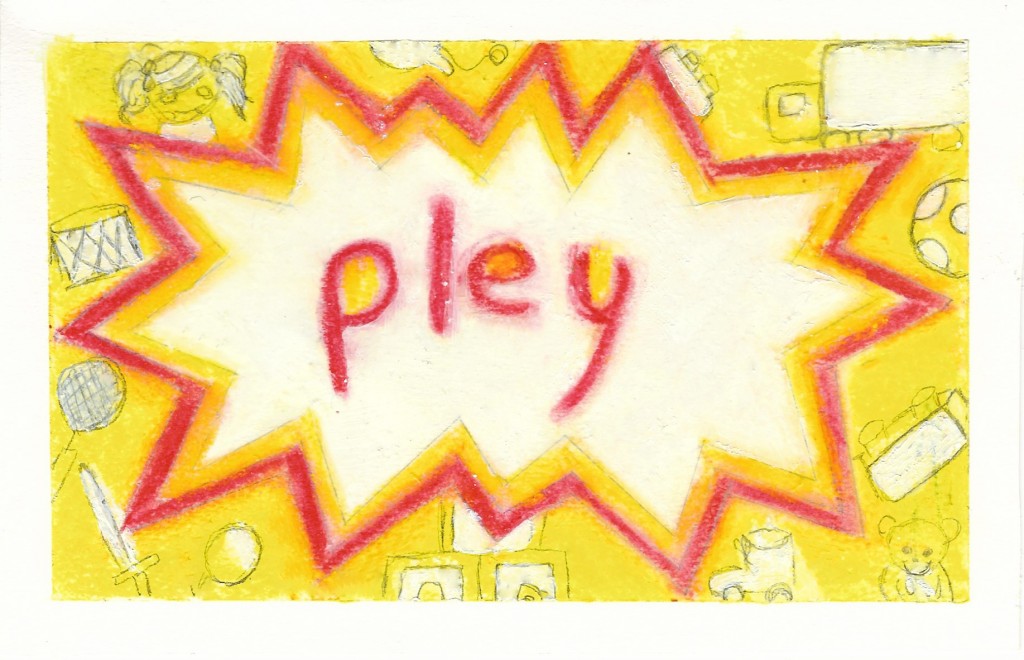 The goal of this assignment was to find an emerging development that is a community practice. I decided to focus on the organization Pley. This company allows families to rent Lego play sets. Often times when ever a child grows out of their toys they just dispose of it and the set becomes wasted.
The goal of this assignment was to find an emerging development that is a community practice. I decided to focus on the organization Pley. This company allows families to rent Lego play sets. Often times when ever a child grows out of their toys they just dispose of it and the set becomes wasted.
This service allows children to experience an unlimited amount of toys. Instead of just chucking away something they get bored with, they simply return it to the company who will then send it to another child requesting the toy.
So far the company is only limited to Legos, but I think this is a wonderful business model that can expand to other products as well.
The company would target families, but and even closer niche market would be for Teen Parents. This group of people don’t have a lot of money to spend on their children because they aren’t earning their own income and they are still in school themselves. This company would give families who can’t as easily afford toys the opportunity to be able to provide them for their families.
Circle Line ReDo
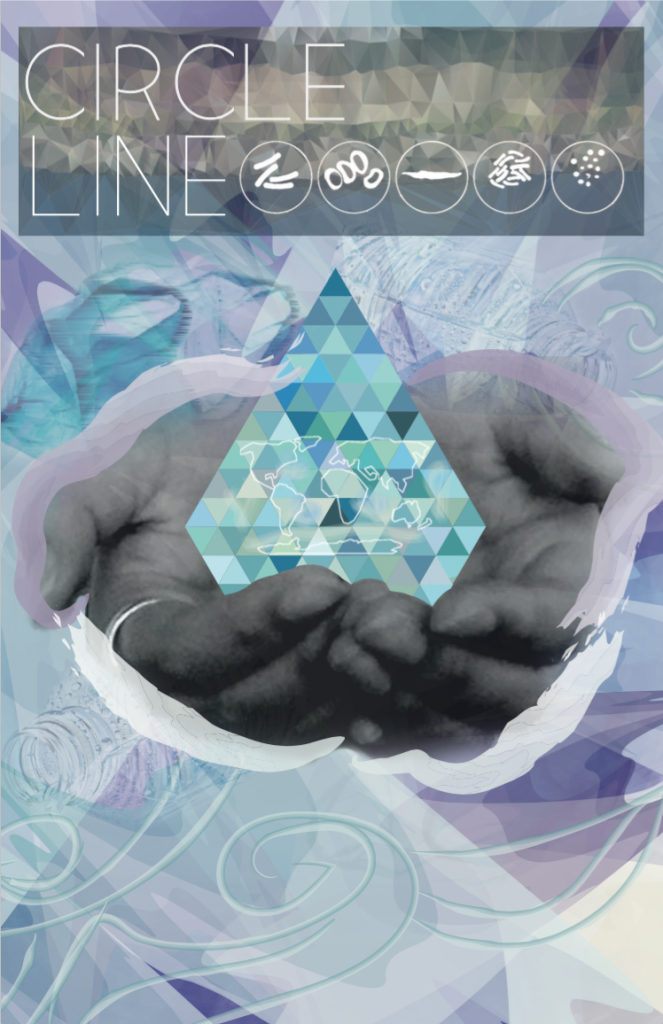
Originally when depicting the Circle Line in a visual composition, I decided to focus on the Albatross Birds. This time I wanted to create a whole new type of composition to correlate to the powers of 10. Click here for previous post.
My inspiration for this peace was The Global Citizen Festival. I think this event is interesting because it is non-profit and is able to gather almost 70,000 people each year to promote awareness to causes such as education, poverty, and even water conservation. An important visual piece such as concert posters are often times used to promote events such as this.
Through Photoshop and Illustrator I decided to create a concert poster inspired piece for the Circle Line.
The Powers of 10 laid throughout the piece very subtly so the composition would not be too over whelming.
The First power of 10 would be 10^1 where it zooms out to the coast line of the Gowanus Canal. I placed that image behind the logo. Originally the image was a photograph of the shore where garbage was collected onto the rocks. To stylized the piece I turned the photo into a polygraph composition
Here is the original photo:
The Next Power of Ten is 10^7 where you are able to see the earth. Here I wanted to display a map of the world and its surrounding water. I also created a swirl pattern in the poster to depict where the main gyres are located.
Third we start to zoom back in again to 10^0.2 where the background of the poster is the water of the Gowns canal and in it you can see floating images of plastic bags and water bottles.
Around 10^-2 is the size of water droplet which is the shape I am holding in my hands.
The last power I included was around 10^-4 which is all the bacteria and amoeba that can be found in water due to pollution from plastics and other non decomposable resources that can be found in our water ways.
Note that the image of the bacteria did come from a post on https://www.globalcitizen.org/en/
Natural Dying Process
Purchasing
- The first part of this process was to purchase the products that would be used to dye the material. I bought Mum Buddy which was a purple flower, chrysanthemum, a more yellow tinted flower, and Concorde grapes. For a small tub of grapes, they cost around $7. Each bouquet of flower cost around $20 each.
Cleaning and Mordanting
- Started dying process the day after the materials were bought.
- First boiled the cloth material in 4-5 cups of water with Tide for an hour. 4th Heat setting out of 9
- Began making mordant: 5 cups of water, 2 tsp of Alum Powder, 2 tsp of Soda Ash, 1 ½ tsp or Tartanic, ½ tsp of soda
- Boiled material in mordant for 45 minutes and let cool for 20 minutes
Dying1
- Split the material in half and started with the purple dye
- Placed 60 stalks of purple flowers in pot with 4-5 cups of water and boiled for about 30 minutes
- Added 2 tsp of salt for more vivid color
- Cooked material in dye solution for about 1 hour
- Poured in plastic container to ferment over night
Dying2
- Placed 9 buds and 13 Flowers’ petals in pot and boiled for 30 mins.
- Added 2 tsp of salt for more vivid color
- Cooked for 1 hour
- Poured dying solution and material into container overnight
- Yellow came out vivid color the next day, so fabric was rinsed and left out to dry over night
- Purple did not dye as properly, so decided to red dye with grapes
Dying3
- Used 161 grape peels to repeat dying process and fermentation
- Added 2 tsp of salt for more vivid color
- This material dyed a lot better.
Clean up
- Kept plastic tubs to store the fabrics, pot will be kept although not used again to cook anything.
- Dye was accidentally dumped down drain instead of kept as a more eco friendly solution for disposal
More on my reflection of the assignment here
